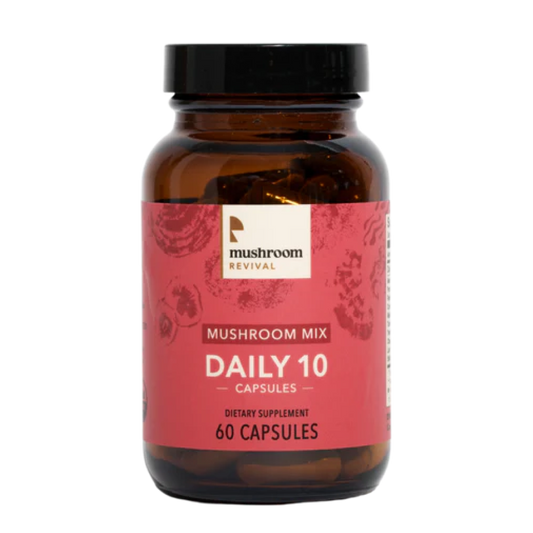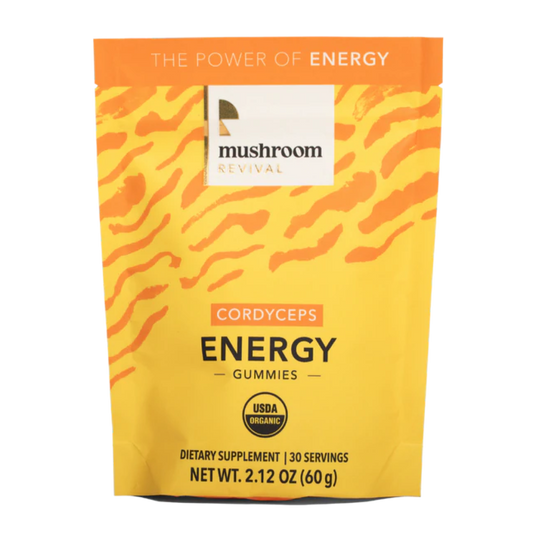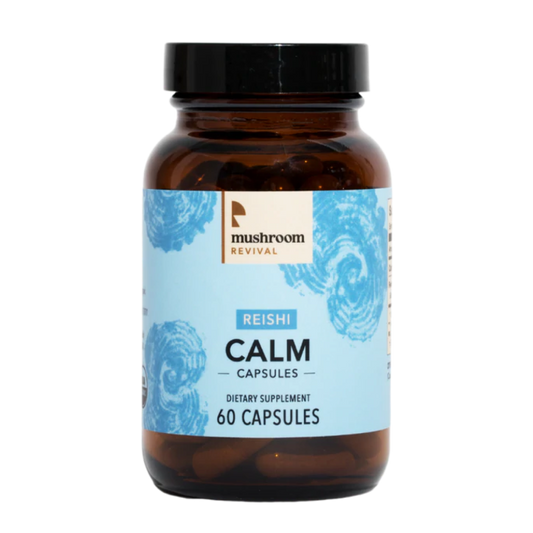Where to Find Lion’s Mane Mushroom: A Guide for Beginner’s

Chaga, turkey tail, reishi, cordyceps: If you haven’t noticed, the wellness space is abloom with functional mushrooms. Whether you’re eyeing new skincare products or searching for a caffeine alternative to avoid that mid-day crash, chances are solid functional fungi have caught your attention—so much so that deciding between shiitake and maitake mushrooms may feel like a dizzying experience.
But if there’s one functional mushroom that stands out from the pack, it’s lion’s mane mushroom. Praised the world over for brightening brain bulbs everywhere and frequently referred to as the real “fountain of youth,” the fungi has proved to be as fierce as its name.
But, does it live up to the hype?
Here’s where to find lion’s mane and why you should seek it out, either purchased online or foraged out in the wild.
What is a Lion’s Mane Mushroom?
“Lion’s mane mushrooms” are known by a few different names. But they all refer to the one you might hope to forage for, whether that’s in the forest or on the shelves of your favorite health food store. It’s scientifically known as Hericium erinaceus, the Hericium here is the Latin word for hedgehog.
We’d suggest that its most common nickname is much more fitting: the shaggy white fungi bears have an uncanny resemblance to a hedgehog, sure, but even more so to a lion’s mane mushroom. Still, it goes by a whole handful of other monikers, too, including:
- Bearded tooth fungus
- Satyr’s beard
- Hou tou gu (or “monkey’s head mushroom” in Chinese)
- Yamabushitake (or “mountain priest mushroom” in Japanese)
- Pom pom mushroom
Where Do Lion’s Mane Mushrooms Come From?
The “mountain” in the name above is no coincidence: Lion’s mane mushrooms grow in the milder, even chilly temps of deciduous forests throughout North America, Europe, and Asia. They typically sprout independently or in pairs on hardwood trees that include:
- Oak Trees
- Beeches
- Maples
What is the History of Lion’s Mane Mushrooms?
Lion’s mane mushrooms have a rich, extensive history. They have been used in Traditional Chinese practices since the Ming Dynasty.
Lion’s mane has been called upon throughout Asia for centuries, where it supports five of the body’s most important organs: the heart, liver, spleen, kidneys, and lungs. As such, it’s historically been used to:
- Support gut and spleen health
- Help to maintain a healthy nervous system for the brain and body
- Support metabolic function
- Support energy and endurance
Lion’s Mane Mushroom Benefits
Today, lion’s mane mushrooms are valued for similar reasons. They operate as adaptogens, which means they promote homeostasis in the body and overall well-being in one fell swoop.
They’re also praised for:
- Supporting mental clarity, focus, and memory
- Supporting your mood
- Promoting overall health and wellness
What’s more, they're an edible mushroom that's straight-up delicious, and finding them either in a forest or at the farmer’s market can feel like a major win.
Finding and Foraging For Lion’s Mane Mushrooms
Foraging isn’t just plain fun. It’s also a benefit for your health and the health of the environment. Plus, few things taste better than wild food you’ve found and cooked on your own (and trust us here: Lion’s mane mushroom is especially sumptuous when sauteéd in butter).

If you’re searching for areas in the United States, you might have the best luck foraging in:
- Minnesota
- Florida (and throughout the South)
- The Great Plains
- North Carolina
Tips on Foraging for Lion’s Mane Mushrooms
One of the biggest perks of foraging for lion’s mane is that its appearance is distinct. Meaning, unlike other wild functional mushrooms that could easily be confused with a poisonous species, lion’s mane is by and large unmistakable (even if it does have some lion’s mane look-alikes).
That said, you might want to keep these tips in mind before you lace up your boots and step into the forest:
- Narrow your search to forests that feature the trees that lion’s mane mushrooms favor (those oaks, beeches, and maples we touched upon above)
- Scout out fallen tree trunks, wounded trees, tree cavities, and trees that have lost their leaves: These are places where lion’s mane most often take up residence
- Search for growths that have long, white, hair-like spines, approximately 15 inches wide at full-size
- Plan your foraging trip for cooler (but not freezing) times of year, depending on where you’re going: winter in the southeast section of the US and fall in the northeast before frigid temps arrive
- Bring a pruner on your search, as the fungi can grow 40 feet high up a tree
- Harvest lion’s mane mushroom immediately: they can grow from just right to inedible quickly
- Use a sharp knife to dislodge the fungi from the wood, shake off any bugs that might have clung to it, and clean it thoroughly before cooking
Also, if you happen to find a spot near your home that’s flourishing with lion’s mane, mark the area. The mushroom has a tendency to fruit from the same area year after year.
What Time of Year Can You Find Lion’s Mane Mushrooms?
The best time to find full, fruiting Lion’s mane mushrooms is late summer to early fall. If you see a Lion’s mane mushroom and aren’t sure whether or not it’s ready for harvest, look for its coloring. That beautiful creamy-white color is what you want. If it’s gone yellow or brown, it is too late to harvest and enjoy.
Additionally, Lion’s mane mushrooms will be quite large when they’re ready to harvest—typically the size of your fist or even larger. So, if you’re foraging in the summer and you spot golfball-sized Lion’s mane mushrooms, trek back out to the site in a few weeks, and you might get a more fruitful harvest.
Purchasing Lion’s Mane Mushrooms
Investing in a lion’s mane product (or fresh from a grocery store) may not feel as adventurous, but let’s face it: It’s a substantially faster and more convenient way to enjoy the fungi.
Fortunately, lion’s mane is available in a bunch of forms, including:
- Capsules and supplements
- Teas
- Gummies
- Powders, which is a great way to preserve lion's mane to add to everything from smoothies to shakes
- Tinctures
- Blends, such as lion’s mane coffee
Lion’s mane can also be purchased dried, which you can cook with olive oil to use in recipes or ground up to prepare in tea. As for lion's mane mushroom taste? Many people compare it to the tender, mildly sweet flavor of seafood with a slight meaty texture.

Can You Get Lion’s Mane Mushrooms from the Grocery Store?
Yes, Lion’s mane mushrooms are available to buy from some grocery stores. While Lion’s mane probably won’t be on the shelves at your local corner store or convenience store, the fluffy fungi can sometimes be spotted at specialty food stores or purveyors of locally foraged and grown food.
The price of Lion’s mane mushrooms from a grocery store will vary depending on the retailer and the region you’re in. But generally speaking, Lion’s mane mushrooms are one of the pricier mushrooms in the store—steeper than their white-button cousins you might find nearby. Be prepared to pay between $10 and $20 per pound of Lion’s mane. But trust us: the few extra dollars are well worth it!
Can You Buy Lion's Mane Mushroom Growing Kits?
If you can't seem to find any decaying trees or dying hardwood trees with the quintessential lion's mane mushroom teeth growing from them, and your local grocer doesn't supply them, don't worry. You can try your hand at growing your own lion's mane using at-home mushroom grow kits.
Mushroom growing kits are often available to purchase online for a variety of mushrooms, including lion's mane, oyster mushrooms, and even shiitake.
Are There Any Lion’s Mane Mushroom Lookalikes?
When you’re on the hunt for Lion’s mane mushrooms—whether at the grocery store or your local forest—it’s helpful to know about any imposters that could aid in confusion. When it comes to mushrooms, it’s essential to be aware of “lookalikes” of the mushrooms you’re looking for, especially toxic lookalikes, to ensure you don’t ingest any poisonous mushrooms.
As a rule of thumb, if you’re new to mushroom foraging, get an expert’s seal of approval on any mushrooms you forage before consuming them. (It’s helpful to forage with a guide or expert the first few times.)
That said, remember these three common lookalikes the next time you’re out looking for Lion’s mane:
- Bear’s head tooth – This mushroom comes from the same family and genus as Lion’s mane, meaning they are literally cousins. So it’s not surprising that they sport a lot of the same features—namely their creamy white color and “hairy” appearance. The good news is that Bear’s head tooth mushrooms are not considered poisonous, so there’s less of a risk in confusing one for the other.
- Coral tooth fungus – This similar mushroom is easily identifiable by its nickname “coral tooth,” as it closely resembles the shape of coral reef while maintaining the Lion’s mane “hair-like” texture and appearance. You’ll often find coral teeth, also known as comb teeth, on dead or dying trees and large logs. Like bear’s head tooth, coral tooth mushrooms are also edible mushrooms.
At the end of the day, you can feel at least somewhat confident that you’re dealing with Lion’s mane mushrooms when its growth forms in bulbs or small “pom-poms.” On the contrary, both bear’s head tooth and coral tooth mushrooms grow a bit more spread out.
To get a foolproof idea of the shape, size, and texture of Lion’s mane mushrooms, we recommend buying some from a grocery store (if you can find it) and holding it in your hand. Get a feel for its shape, weight, and size compared to your palm. This will help you spot the familiar fungi in the wild—without mistaking it for its genetically similar cousins.
What to Look For in a Lion’s Mane Product
Unless you’ve opted for fresh or dried lion’s mane, be sure that the supplement, powder, tincture, or product you purchase is up to standards. You can determine this by ensuring the item:
Doesn’t feature any outlandish claims
Lion’s mane falls under the umbrella of herbal supplements. This translates to the fact that companies are legally prohibited from making outrageous assertions like “great for brain injury” (a real-life example of a product that was pulled from the shelves by the FDA). Steer clear of products that promise the supplement to be the "be-all-end-all" solution of your dreams.
Has received the stamp of approval
Given the popularity of lion’s mane, numerous fly-by-night brands have popped up online; thus, it’s important to purchase products only from reputable brands that have received certifications from the USDA, comply with NSF FDA regulations, and are environmentally responsible.
Features the right ingredients
As with other functional mushroom products, be sure that the one you choose is made from the fruiting body of lion’s mane, where its most powerful agents rest.
In fact, the fruiting body of lion’s mane mushrooms contains 8 classes of compounds that have been shown to support NGF and cognitive function. This includes Hericinones, Dilinoleoyl-phosphatidylethanolamine (DLPE), amyloban, amycenone, 3-Hydroxyhericenone F, Hericene, Hericerin, and erinacerin. In contrast, the mycelium of the mushroom, or the non-fruiting root end, does not contain these compounds.
The fruiting body also has up to 29 times more 1,3 and 1,6 glucans compared to the mycelium. These are just a few reasons why you should choose products that prioritize the fruiting body of lion’s mane to get the most out of the fungi.
Tune In (and Mellow Out) with Mushroom Revival
Lion’s mane mushroom has skyrocketed to the top of the functional mushrooms hierarchy for a sound reason: The fungi is as delectable as it is a hug for your brain. From serving as the perfect substitute for meat in vegetarian recipes to supporting mental clarity, lion’s mane mushrooms deserve every ounce of their fame.
Mushroom Revival celebrates its powers. Our Focus Lion’s Mane Capsules harness the fruiting bodies of the fungi to help promote your memory, concentration, well-being, and more. And as the first certified organic mushroom capsule in the world, you know you’ll have your hands on the highest quality product on the market.

Explore the world of functional mushrooms with Mushroom Revival.
FAQs
If you’re just now getting into lion’s mane mushrooms, you may have several questions. Here are a few of the most common we receive and their answers:
Can you eat lion’s mane raw?
Technically, yes; safety-wise (after you’ve meticulously cleaned the fungi after foraging or purchasing it fresh), nothing precludes you from eating lion’s mane raw. That said, lion’s mane, like all mushrooms, features chitin—a fibrous polysaccharide that’s difficult for humans like us to digest. That’s why we highly recommend cooking lion’s mane as opposed to eating it raw. Your stomach will feel better, and they’ll taste better, too.
Are there side effects to lion’s mane?
Lion’s mane is considered safe, but you may want to dodge them if you know you have a sensitivity or allergic reaction to other mushrooms. If you’re planning on taking a lion’s mane supplement and are unsure of how you will tolerate it, make sure to consult with your physician first.
When should I take lion’s mane?
The answer to when to take lion’s mane depends entirely on your schedule and preferences and what you hope to gain from supplementing with it. If you’re looking for extra productivity, take it in the morning; if you’d like to use it to ease into a more restful state of mind, take it at night.
Is lion’s mane psychedelic?
In a word: No, lion’s mane is not psychedelic, as it doesn’t contain the psychoactive compound psilocybin.
Where to Find Lion’s Mane Mushroom
Generally speaking, there are two ways to get your hands on lion’s mane mushrooms: literally, through foraging and by purchasing a supplement or product.





























